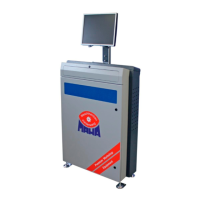42 BA052301-en
3 Installation
3.1 Requirements for the Place of Installation
The room in which the dyno is to be operated must satisfy all official regulations for the
operation of equipment in the workplace.
An adequate fresh-air supply and an exhaust shaft should also be available.
3.2 Safety Measures
The following technical safety precautions must be observed by the customer at all times.
Disregarding these precautions can be life-threatening even for those who enter the room for
only a very short period.
3.2.1 Heat Balance
Rough calculation for diesel and Otto engines
The available energy in fuel is taken as standard. This is specified as fuel power with 100 % and
is divided as follows:
Engine power (mechanical)
Degree of effectiveness over the entire RPM range
Heat flow over the engine block surface and engine components.
Coolant heat flow (is transmitted via the vehicle cooler)
Heat flow via the surface of the vehicle exhaust system
Heat volume in the test room
P
1
+ P
2
+ P
3
+ P
4
P
1
: Is converted to heat by the air cooled eddy current brake and normally emitted into the test room.
P
5
: This energy is suctioned out with the exhaust suction system and does not contribute to heat volume in the test
room.
Generally speaking the engine power to be measured is known. If this is specified with 1, the
following factors are given:
Heat flow surface engine block
Heat flow vehicle exhaust system
The heat volume in test room is then: 1 + 0.8 + 0.7 + 0.5 = 3
This means that the energy quantity of the engine power multiplied by 3 is the volume of heat
energy in the test room.
Heat flow surface engine block
Heat flow vehicle exhaust system
Separate suction of the heat energy P
1
converted by the eddy current brake can considerably
lower the burden on the room.
The heat volume in the test room would then be: + 0.8 + 0.7 + 0.5 = 2
This means that the energy quantity of the engine power multiplied by 2 is the volume of heat
energy in the test room.

